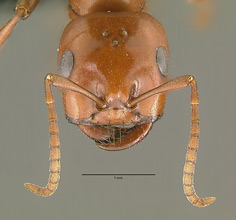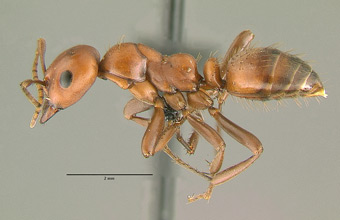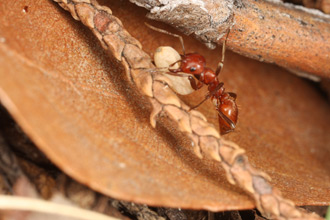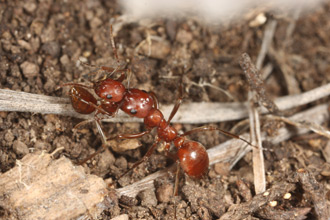- Identification
- Medium large workers with distinctive sickle shaped mandibles that have no teeth. Color varies from concolorous yellowish-red to individuals with a deeper red head and thorax, and a dusky red gaster.
- Biology
- Polyergus breviceps are obligate slave makers. Workers raid nests of Formica species to steal their brood and pupae. Most of these stolen ants are used for food but some of the pupae are left to eclose in the Polyergus nest. These ants join other workers in carrying out of most of the tasks within the colony. This includes feeding the Polyergus adults, brood, and queen, tending the queen, managing all aspects of brood care and performing nest maintenance. The only roles not filled by the foreign workers are egg laying and raiding.
- additional biology notes...
- Distribution
- Range
- Canada and United States. Ontario and Michigan westward to British Columbia and southwestward to Indiana, Illinois, Missouri, Kansas, New Mexico, Arizona, Nevada, and California.
- Navajo Reservation Records
- Collection records being processed.
- Additional Notes
- Raids
- Raids are carried out in the late afternoon, beginning with a growing group of frenetic workers gathering outside of and circling their own nest. Prior to this time a small number of scouts have been searching the local area for foreign nests to raid. A returning scouts emits pheromones that induce some workers to follow its lead, which is immediately followed up by all the workers circling the nest en masse and then moving off in a single direction. Additional workers will also follow up this initial burst of workers away from the colony and join the raiding party. This mass of workers moves as a fairly cohesive group that can travel at a rate of 2 to 3 m per minute. The scout returns to the foreign nest using visual cues for guidance. As the scout leads the raid, the scout and other workers deposit a pheromone trail along the route being followed. From hundreds to more than two thousand individuals can take part in a raid.
- Once reaching the nest of the foreign species workers search for and, once found, begin entering the nest entrance. Soon thereafter individuals exit the nest carrying a larva or pupae. Laden Polyergus workers begin running back to their own colony, following the same route they used for their arrival. Other workers need to wait for others entering, and then exiting, the colony before they can enter the foreign nest. Workers carrying stolen brood may be able to make it back to their own colony before all the raiding ants have made their way into the foreign nest.
- Raids typically are completed within an hour and can secure from hundreds to thousands of stolen larvea and pupae. In cases where an attacked colony is particularly large the raid may be extended over a longer period of time. Individuals may make two round trips to the attacked nest. The number of raids carried out over the course of a year (from none to dozens) suggests the stimulus for raiding is the need for more workers. The majority of raids end without the raiding ants locating a colony of a foreign species. In unsuccessful raids workers stop advancing, milling about in a particular area where they are apparently searching for a non-existent or simply unfound nest entrance. After a few minutes of milling about an incohesive retreat back to the home colony begins. Through time more and more workers join in returning to the nest once the raid abandonment process begins.
- This account is based on Topoff et al. 1985a, Topoff et al. 1985b, Wheeler and Wheeler 1986 and Bono et al. 2006.
- Nest Founding
- New queens may exit their natal nest with a raiding column, mate with a male while in the column and then attempt to enter the nest of a Formica species. If successful, she will eventually kill the host queen and any remaining Formica workers will stay with the colony and care for her Polyergus brood.
- Habitat
- Polyergus breviceps nest in a wide variety of habitats including meadows, other treeless habitats and open woods. Nests locations and its structure vary since these characteristics are dependant on the Formica species that Polyergus breviceps queens exploit. This host species can vary from habitat to habitat and between different portions of its range.
- Etymology
- Morphology: L. brevis short + L. -ceps head
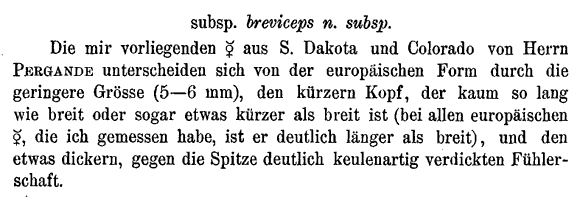
- Literature
- Bono, J. M., E. R. Gordon, M. F. Antolin, and J. M. Herbers. 2006. Raiding Activity of an Obligate (Polyergus breviceps) and Two Facultative (Formica puberula and F. gynocrates) Slave-Making Ants. Journal of Insect Behavior. 19:429-446.
- Emery, C. 1893. Beiträge zur Kenntniss der nordamerikanischen Ameisenfauna. Zoologische Jahrbücher, Abteilung für Systematik, Geographie und Biologie der Tiere. 7:633-682.
- Topoff, H., M. Inez-Pagani, L. Mack, and M. Goldstein. 1985a. Behavioral ecology of the slave-making ant, Polyergus breviceps, in a desert habitat. Southwestern Naturalist. 30:289-295.
- Topoff, H., B. LaMon, L. Goodloe, and M. Goldstein. 1985b. Ecology of raiding behavior in the western slave-making ant Polyergus breviceps (Formicidae). Southwestern Naturalist. 30:259-267.
- Wheeler, G. C. and J. Wheeler. 1986. The ants of Nevada. Natural History Museum of Los Angeles County, Los Angeles.
- A note about these publications. The literature cited here is not meant to be an exhaustive list of papers published about this species.
Page authored by David Lubertazzi and Gary Alpert
